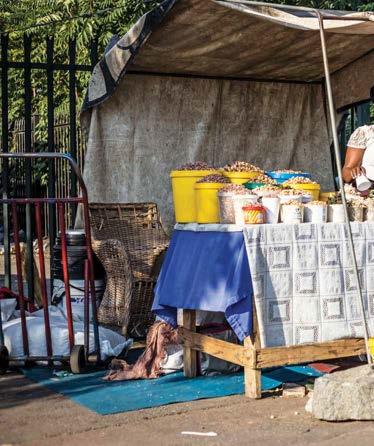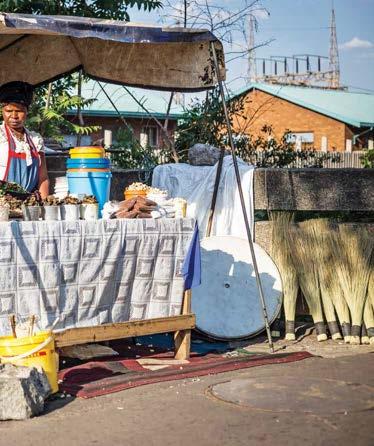
6 minute read
SUPPLY CHAIN
Nwafor added that the agency had been delighted to find that it is cheaper and more productive to do business online.
He noted that the growth of digital marketing in Nigeria, influenced by increased uptake by Nigerians of e-commerce businesses, resulted in improved internet connectivity and other opportunities for the industry.
As an example, Alternative Adverts Network Services created its own digital platform that enabled clients to pay for services on global platforms such as Google, Instagram and Facebook with the local naira currency, rather than the US dollar which is restricted in that market.
Nwafor said the pandemic also opened up easier opportunities for cross-regional agency collaborations and, in the second quarter of 2021, he received three to four proposals from agencies based in South Africa and Kenya wanting to explore partnerships – without having to hop from one country to another for discussions.
SA INDUSTRY’S BIG SETBACK
Karabo Songo, CEO of Brave group – a mid-sized South African agency – said the country’s stringent lockdown regulations had set the advertising industry back 10 years. Many agencies were fighting for survival and new market entrants were among the hardest hit as they struggled to build sustainable businesses.
Despite the setbacks, Songo pointed to lockdowns contributing to the emergence of new ways of doing business that have the potential to transform the local industry.
“We have fast-tracked the mind of the customer to work on digital platforms in order to deliver projects. We can also play around with talent based in different locations while working on one project,” explained Songo. “This [has] opened the marketplace to new resources and teams outside South Africa – allowing clients to consult with anyone they believe can deliver value. These are just some of the positives of Covid-19.”
LATE PAYMENTS, SMALLER BUDGETS
Founder and chief architect of Johannesburg-based DNA Brand Architects, Sylvester Chauke, said the agency had expectations of doubling its annual revenue in 2020, but the entire business value chain was adversely impacted when the pandemic hit South Africa in March last year.
“We lost revenue from clients that operate in the alcohol, travel and hospitality sectors. Some clients cut back on traditional consumer advertising budgets and channelled funds to other areas of their businesses, especially internal marketing,” he stated. “Late payments, [smaller] budgets and timelines that were moved due to lockdowns also impacted our business.”
To weather the storm, the agency has tightly managed its cash flow and adjusted to conducting business online. The online transition was eased somewhat by international clients already being accustomed to being serviced digitally prior to the pandemic.
Chauke said some of the agency’s gains from the ‘new normal’ included slashing its travel and entertainment budgets, as well as saving the time previously spent travelling back and forth to meetings.
He added that carrying operational expenses such as office space and services that are not used to their full capacity due to work-from-home requirements were among the challenges that DNA Brand Architects continued to experience. However, he was hopeful the agency would be welcoming its SA-based clients back to their offices as soon as businesses adjusted and lockdowns were a thing of the past.
Meanwhile, in common with its counterparts around the world, Africa’s advertising industry must continue to adapt to a new norm that, in most instances, is quite different to the way it conducted business less than two years ago. The challenges are considerable, but there’s a significant upside to be embraced too.
Aurelia Mbokazi is a freelance journalist, editor and development communications specialist with 23 years’ experience in telling impactful stories across Africa on various platforms, including print and the digital space. She has occupied leading roles in national newspapers, magazines and digital platforms.
PHOTOS: SUPPLIED, RAWPIXEL.COM





The challenges of servicing lowvolume momand-pop shops
Tielman Nieuwoudt explains why supply chain experts and pan-African marketers can’t afford to ignore traditional mom-and-pop retail outlets.
SERVICING MOM-AND-POP shops with low volume and limited space is difficult and often expensive.
But these traditional retail outlets also have a unique understanding of local consumer preferences and, for neighbourhood consumers, they can provide value not always matched by large retailers. Their demise will take some time, even with the growth of modern trade in emerging markets.
Mom-and-pops, or micro-retailers, are known by many names in different parts of the world: ‘kirana’ in India; ‘baqala’ in the Gulf; ‘sari-sari’ in the Philippines; ‘duka’ in East Africa; ‘spaza’ in South Africa; ‘souk’ in Ethiopia; and ‘tiendita’ in Mexico.
The World Bank estimates that there are close to 400-million micro, small and medium enterprises (MSME) in emerging economies, both in Africa and elsewhere. For example, there are 12-million in India alone and they account for almost half of all grocery sales.
What are micro-retailers? Definitions can vary, but they are often classified as enterprises employing fewer than four people, with a monthly turnover of

Shops are usually small, ranging from 25-50 sq m
less than US$2 000 a month. They are generally independent and stock a small selection of products or stockkeeping units. They may trade out of fixed locations such as shops, or from mobile locations such as roaming street hawkers. Shops are generally small, ranging from 25 to 50 square metres.
Working with small retailers in emerging markets presents certain difficulties. The following are some factors for marketers and supply chain teams to consider when dealing with micro-retailers.
LIMITED PURCHASING POWER
They have limited cash flow and purchasing power. For cash flow, they often tap into personal savings or reach out to family members. To manage their cash, they prefer to buy smaller quantities and often don’t qualify for minimum drop sizes set by delivery companies.

POOR PRODUCT VISIBILITY AND LIMITED SPACE
Shops tend to be poorly lit and have limited shelf space to stock and display products. Placing equipment such as coolers or promotional and point-of-sale material can be challenging.
HARD TO INTRODUCE ADDITIONAL BRANDS
Micro-retailers stock limited brands per product category – often two to three. With constrained purchasing power, they are hesitant to tie up their limited cash with slow-moving products. Convincing shopkeepers to purchase additional brands is therefore difficult – especially new and untested products in the market.
NEED FREQUENT DELIVERY
Many small groceries run out of stock regularly. They often need high-frequency delivery – in some cases daily. Low-volume drop sizes increase the cost per delivery, resulting in them being unprofitable outlets to service.

›The World Bank estimates that there are close to 400-million micro, small and medium enterprises (MSME) in emerging economies, both in Africa and elsewhere. They will typically employ fewer than four people and have a monthly turnover of less than US$2 000
OUTLETS MAY BE HARD TO REACH
Many micro-retailers are in hard-toreach areas and congested urban centres. In some cases, vehicles can’t enter small narrow streets – delaying sales teams, which sometimes need to travel on foot to reach outlets.
UNREGISTERED AND UNDERSERVED
Many owners don’t register their shops to avoid paying taxes. Furthermore, the lack of street signage in some emerging market locations makes it difficult for companies to assign them to formal delivery routes. As a result, microretailers often remain underserved, leaving this important retail base to informal distributors and wholesalers.
RELIANCE ON WHOLESALERS
Micro-retailers frequently make use of wholesalers or distributors to break bulk into smaller and more affordable quantities. These wholesalers and distributors will also provide credit when required. Smaller quantities are more economical in some respects, but the shopkeepers often end up paying higher prices because of their low










